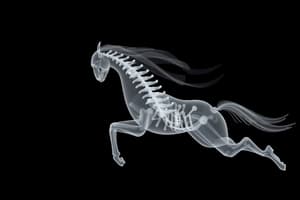Podcast
Questions and Answers
What is a frame of reference?
What is a frame of reference?
A point or place that we pretend is not moving and measure motion compared to this point.
What is displacement?
What is displacement?
The net (total) change in position; distance in a given direction.
What is position in terms of motion?
What is position in terms of motion?
Separation between an object and the origin.
What is distance?
What is distance?
What defines a vector quantity?
What defines a vector quantity?
What defines a scalar quantity?
What defines a scalar quantity?
What is motion?
What is motion?
How is speed calculated?
How is speed calculated?
How is velocity defined?
How is velocity defined?
What is the slope in the context of motion?
What is the slope in the context of motion?
What does it mean to interpolate data?
What does it mean to interpolate data?
Flashcards are hidden until you start studying
Study Notes
Essential Concepts of Motion
- Frame of Reference: A stationary point or location from which motion is measured.
- Displacement: The overall change in position, emphasizing direction; it is the straight-line distance from the starting point to the ending point.
- Position: The specific location of an object relative to a chosen origin point.
- Distance: The total length of the path traveled by an object, measured in meters (m) in the International System of Units (SI).
Measurement Classifications
- Vector Quantity: Represents measurements that include both magnitude (size) and direction, essential for understanding motion.
- Scalar Quantity: Represents measurements that include only magnitude, without any regard to direction.
Motion and Related Concepts
- Motion: Defined by both distance and displacement, the concept also requires time to express how positions change.
- Speed: Calculated as total distance traveled divided by total time taken, usually expressed in meters per second (m/s).
- Velocity: Defined as displacement per unit of time; also expressed in meters per second (m/s) and includes directional information.
Graphical Interpretation
- Slope: Represents the ratio of vertical change (rise) to horizontal change (run), calculated as (y2 - y1) / (x2 - x1); it is synonymous with velocity in a motion graph.
- Interpolation: The method of estimating unknown values within the range of a discrete set of known data points, often utilized in graph analysis to draw conclusions.
Studying That Suits You
Use AI to generate personalized quizzes and flashcards to suit your learning preferences.




